
fsdp_qlora
Training LLMs with QLoRA + FSDP
Stars: 1384

The fsdp_qlora repository provides a script for training Large Language Models (LLMs) with Quantized LoRA and Fully Sharded Data Parallelism (FSDP). It integrates FSDP+QLoRA into the Axolotl platform and offers installation instructions for dependencies like llama-recipes, fastcore, and PyTorch. Users can finetune Llama-2 70B on Dual 24GB GPUs using the provided command. The script supports various training options including full params fine-tuning, LoRA fine-tuning, custom LoRA fine-tuning, quantized LoRA fine-tuning, and more. It also discusses low memory loading, mixed precision training, and comparisons to existing trainers. The repository addresses limitations and provides examples for training with different configurations, including BnB QLoRA and HQQ QLoRA. Additionally, it offers SLURM training support and instructions for adding support for a new model.
README:
Training LLMs with Quantized LoRA + FSDP.
Read our announcement blog post.
You should treat this script as an alpha/preview release. If you’re not comfortable with testing and debugging models, we’d suggest holding off for a few months while the community more fully tests the approach.
FSDP+QLoRA has been integrated into:
- Axolotl: experimental support
The following steps should work (tested on Cuda 11.7, 11.8 and 12.1):
- Clone https://github.com/AnswerDotAI/fsdp_qlora
-
pip install llama-recipes fastcore "transformers!=4.38.*,!=4.39.*" --extra-index-url https://download.pytorch.org/whl/test/cu118as an easy way to get most dependencies (replace 118 with your desired Cuda version) - Install bitsandbytes
pip install bitsandbytes>=0.43.0 - Run
huggingface-cli login(to access Llama 2) - Optional Libraries:
- HQQ quantization: follow the HQQ installation instructions. Our training script uses
HQQBackend.ATEN_BACKPROP, so also make sure to build the custom kernelscd hqq/kernels && python setup_cuda.py install. - Weights and Biases logging:
pip install wandb
- HQQ quantization: follow the HQQ installation instructions. Our training script uses
- Pytorch >= 2.2 is recommended to make use of the native flash-attention 2 kernel.
Once installed, run cd fsdp_qlora and then run the following command to begin finetuning Llama-2 70B on Alpaca at a maximum sequence length of 512 tokens.
python train.py \
--model_name meta-llama/Llama-2-70b-hf \
--batch_size 2 \
--context_length 512 \
--precision bf16 \
--train_type qlora \
--use_gradient_checkpointing true \
--use_cpu_offload true \
--dataset alpaca \
--reentrant_checkpointing trueThis example command currently uses just over 128GB of CPU RAM. If you only have 128GB available, we recommend making a 10-20GB swap file to accommodate the initial spike in usage.
For quantization we support HQQ and bitsandbytes. We're currently doing benchmarking to help you decide which to use. If you do use bitsandbytes, be sure to pass --reentrant_checkpointing True to avoid triggering a bug in bitsandbytes which results in high memory usage (a fix is in progress).
Full params fine-tuning.
export CUDA_VISIBLE_DEVICES=4,5 # optionally set devices
python train.py \
--world_size 2 \ # optional, on a single machine will be set automatically
--master_port 12356 \ # optional, defaults to 12355
--model_name meta-llama/Llama-2-7b-hf \
--gradient_accumulation_steps 4 \
--batch_size 8 \
--context_length 512 \
--precision bf16 \
--train_type full \
--use_gradient_checkpointing true \
--use_cpu_offload false \
--use_activation_cpu_offload false \
--log_to wandb \
--dataset alpacaLoRA fine-tuning using HF PEFT library.
- --train_type full \
+ --train_type lora \LoRA fine-tuning using a custom LoRA module.
- --train_type full \
+ --train_type custom_lora \4-bit quantized LoRA fine-tuning using bitsanbytes Linear4bit layer with NF4 quantization and HF PEFT library.
- --train_type full \
+ --train_type qlora \
+ --reentrant_checkpointing true \4-bit quantized LoRA fine-tuning using bitsanbytes Linear4bit layer with NF4 quantization and a custom LoRA module.
- --train_type full \
+ --train_type custom_qlora \
+ --reentrant_checkpointing true \4-bit quantized LoRA fine-tuning using HQQ library and a custom LoRA module.
- --train_type full \
+ --train_type hqq_lora \4-bit quantized DoRA fine-tuning using bitsanbytes Linear4bit layer with NF4 quantization and a custom DoRA module.
- --train_type full \
+ --train_type bnb_dora \4-bit quantized DoRA fine-tuning using HQQ library and a custom DoRA module.
- --train_type full \
+ --train_type hqq_dora \4-bit quantized Llama-Pro fine-tuning using bitsanbytes Linear4bit layer with NF4 quantization.
To create llama-pro weights, run the following command:
python scripts/block_expansion.py \
--model_name meta-llama/Llama-2-7b-hf \
--output_dir /path/to/llama_pro_weights_directory \
--expansion_rate 0.1- --train_type full \
+ --train_type bnb_llama_pro \
+ --llama_pro_path /path/to/llama_pro_weights_directory \4-bit quantized Llama-Pro fine-tuning using HQQ library.
To create llama-pro weights, run the following command:
python scripts/block_expansion.py \
--model_name meta-llama/Llama-2-7b-hf \
--output_dir /path/to/llama_pro_weights_directory \
--expansion_rate 0.1- --train_type full \
+ --train_type hqq_llama_pro \
+ --llama_pro_path /path/to/llama_pro_weights_directory \During quantized LoRA training we use a custom quantization and loading code to avoid loading the entire model into GPU memory before sharding it across GPUs. This is the default behavior of our training script when any of the following training options "qlora", "custom_qlora", "hqq_lora" is used. Other training options are already optimized for low memory loading to their best extent.
We load the weights iteratively, quantize them on the GPU and place them back to CPU or meta device (based on their rank) concurrently a few layers at a time. We do this across all GPUs to initialize the quantization parameters, such as zero and scale, while using sync_module_states=True to sync the model parameters and buffers across all GPUs during FSDP initialization.
This will cast all the model parameters to torch.bfloat16 before training and won't use FSDP mixed precision. As a result, sharded and unsharded params will be stored in bf16, forward and backward passes will be done in bf16, and gradient reduction and updates will be done in bf16.
This will cast all the model parameters to torch.float32 before training and won't use FSDP mixed precision. As a result, sharded and unsharded params will be stored in fp32, forward and backward passes will be done in fp32, and gradient reduction and updates will be done in fp32.
This will cast all the model parameters to torch.float32 before training and will use FSDP mixed precision with
mp_policy = MixedPrecision(param_dtype=torch.float32, reduce_dtype=torch.float32, buffer_dtype=torch.float32)
As a results, sharded and unsharded params will be stored in fp32. It will use autocast(torch.float16) for forward and backward passes, and autocast(torch.float16) for gradient reduction and updates.
This will cast all the model parameters to torch.float32 before training and will use FSDP mixed precision with
mp_policy = MixedPrecision(param_dtype=torch.float32, reduce_dtype=torch.float32, buffer_dtype=torch.float32)
As a results, sharded and unsharded params will be stored in fp32. It will use autocast(torch.bfloat16) for forward and backward passes, and autocast(torch.bfloat16) for gradient reduction and updates.
This will cast all the model parameters to torch.bfloat16 before training but will keep the buffers in torch.float32 and will use FSDP mixed precision with
mp_policy = MixedPrecision(param_dtype=torch.bfloat16, reduce_dtype=torch.bfloat16, buffer_dtype=torch.float32)
As a results, sharded and unsharded params will be stored in bf16. It will use autocast(torch.bfloat16) for forward and backward passes, and autocast(torch.bfloat16) for gradient reduction and updates. Buffers and only eligible operations in autocast will be performed in bf16.
This option is important for RoPE layer which gives incorrect results when cast to lower precision especially with longer context lengths.
hf_train.py uses TRL's SFTTrainer for a comparison run. To match with our script, modify the dataloading code to train on everything (not just completions) and then run train.py --train_type qlora --dataset guanaco --batch_size 8 --lr_scheduler cosine --log_to wandb --save_model True --output_dir guanaco_7B --gradient_accumulation_steps 2 --lr 2e-4. The SFTTrainer version has to run with a lower batch size (4 vs 8) so we only do 2 gradient accumulation steps vs 4 in the QLoRA+FSDP version.
If you specify --save_model True the adapter layers will be saved as a state dict. To convert to the regular Hugging Face format and upload to the hub, see: Converting the State Dict.ipynb
If "custom_qlora", "hqq_lora" training options are used, then only the trainable LoRA parameters will be saved. Before inference, you need to load and quantize the base model again, and separately load the saved LoRA parameters.
You can alternatively test to see if merging base model weights and trained LoRA weights and then quantizing them performs similar to keeping the parameters separately as done during training. To make use of torch.compile with HQQ, see https://github.com/mobiusml/hqq/issues/18.
While QLoRA finetuning works with FSDP, there are some rough edges to be aware of with this alpha release and our example script.
First, the current release of Transformer AutoModel.from_pretrained cannot be used to load models into quantized weights, as it does not support the new quant_storage or quantization flag. Loading pretrained models requires writing or using custom model loading code. We provide an example of how to load and quantize a QLoRA model for finetuning in our demo script.
We are actively working with Hugging Face to resolve this incompatibility in future Transformers and PEFT releases.
Second, while FSDP’s Mixed Precision works with QLoRA, practitioners need to be careful to set the MixedPrecision.param_type to match the Linear4Bit.quant_storage dtype. Otherwise, FSDP’s Mixed Precision could cast the quantized weights to a different precision, essentially turning them into random weights. Our example script shows how to avoid this potential pitfall, and we will be happy to assist model training libraries in correctly exposing FSDP’s Mixed Precision options to users when training with QLoRA
# BnB QLoRA
export CUDA_VISIBLE_DEVICES=4,5,6,7
python train.py \
--world_size 4 \
--master_port 12356 \
--model_name meta-llama/Llama-2-70b-hf \
--gradient_accumulation_steps 4 \
--batch_size 2 \
--context_length 512 \
--precision bf16_buffers_autocast \
--train_type custom_qlora \
--use_gradient_checkpointing true \
--reentrant_checkpointing true
--use_cpu_offload false \
--log_to stdout \
--dataset alpaca
# HQQ QLoRA
export CUDA_VISIBLE_DEVICES=4,5,6,7
python train.py \
--world_size 4 \
--master_port 12356 \
--model_name meta-llama/Llama-2-70b-hf \
--gradient_accumulation_steps 4 \
--batch_size 2 \
--context_length 512 \
--precision bf16_buffers_autocast \
--train_type hqq_lora \
--use_gradient_checkpointing true \
--use_cpu_offload false \
--log_to stdout \
--dataset alpacaNote: For large batch size or long context training HQQ LoRA is a bit more memory efficient compared to BnB LoRA with re-entrant checkpointing. So if you are running into OOM issues, try using HQQ LoRA.
See fsdp_multi_node.sh for an example training script using multi-node training with SLURM.
First, import the new model's transformer, attention, and MLP layers from Transformers:
from transformers.models.mistral.modeling_mistral import MistralDecoderLayer, MISTRAL_ATTENTION_CLASSES, MistralMLPThen in the get_wrapping_policy function, add the attention, MLP, and transformer layers to the self_attn_policy_fn, mlp_policy_fn, and transformer_wrap_policy wrapping policy methods:
def get_wrapping_policy(custom_policy:bool=False):
def self_attn_policy_fn(module):
return isinstance(module, tuple(*LLAMA_ATTENTION_CLASSES.values(), *MISTRAL_ATTENTION_CLASSES.values()))
def mlp_policy_fn(module):
return isinstance(module, (LlamaMLP, MistralMLP))
transformer_wrap_policy = functools.partial(
transformer_auto_wrap_policy,
transformer_layer_cls=(LlamaDecoderLayer, MistralDecoderLayer),
)Finally, add gradient checkpointing support by adding the transformer layer to check_fn:
if args["use_gradient_checkpointing"]:
check_fn = lambda submodule: isinstance(submodule, (LlamaDecoderLayer, MistralDecoderLayer))For Tasks:
Click tags to check more tools for each tasksFor Jobs:
Alternative AI tools for fsdp_qlora
Similar Open Source Tools

fsdp_qlora
The fsdp_qlora repository provides a script for training Large Language Models (LLMs) with Quantized LoRA and Fully Sharded Data Parallelism (FSDP). It integrates FSDP+QLoRA into the Axolotl platform and offers installation instructions for dependencies like llama-recipes, fastcore, and PyTorch. Users can finetune Llama-2 70B on Dual 24GB GPUs using the provided command. The script supports various training options including full params fine-tuning, LoRA fine-tuning, custom LoRA fine-tuning, quantized LoRA fine-tuning, and more. It also discusses low memory loading, mixed precision training, and comparisons to existing trainers. The repository addresses limitations and provides examples for training with different configurations, including BnB QLoRA and HQQ QLoRA. Additionally, it offers SLURM training support and instructions for adding support for a new model.
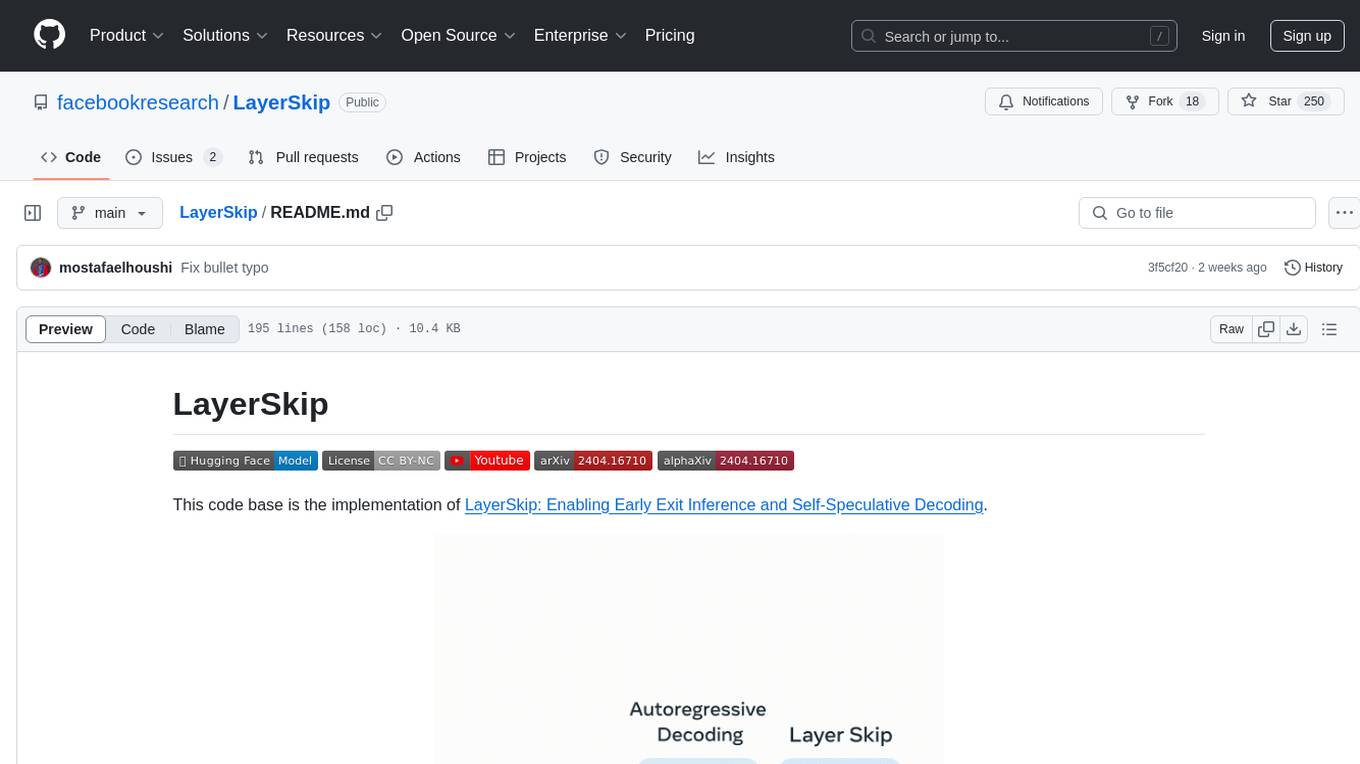
LayerSkip
LayerSkip is an implementation enabling early exit inference and self-speculative decoding. It provides a code base for running models trained using the LayerSkip recipe, offering speedup through self-speculative decoding. The tool integrates with Hugging Face transformers and provides checkpoints for various LLMs. Users can generate tokens, benchmark on datasets, evaluate tasks, and sweep over hyperparameters to optimize inference speed. The tool also includes correctness verification scripts and Docker setup instructions. Additionally, other implementations like gpt-fast and Native HuggingFace are available. Training implementation is a work-in-progress, and contributions are welcome under the CC BY-NC license.
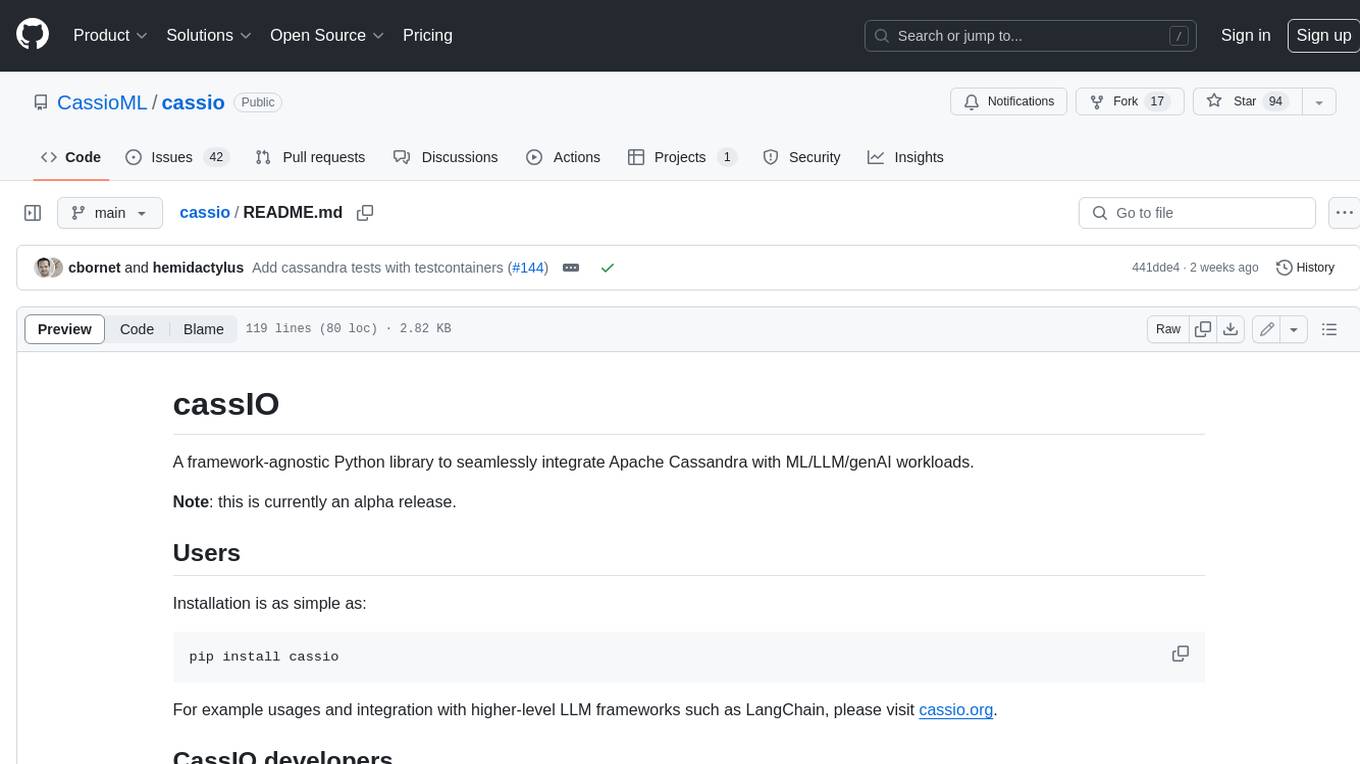
cassio
cassIO is a framework-agnostic Python library that seamlessly integrates Apache Cassandra with ML/LLM/genAI workloads. It provides an easy-to-use interface for developers to connect their Cassandra databases to machine learning models, allowing them to perform complex data analysis and AI-powered tasks directly on their Cassandra data. cassIO is designed to be flexible and extensible, making it suitable for a wide range of use cases, from data exploration and visualization to predictive modeling and natural language processing.
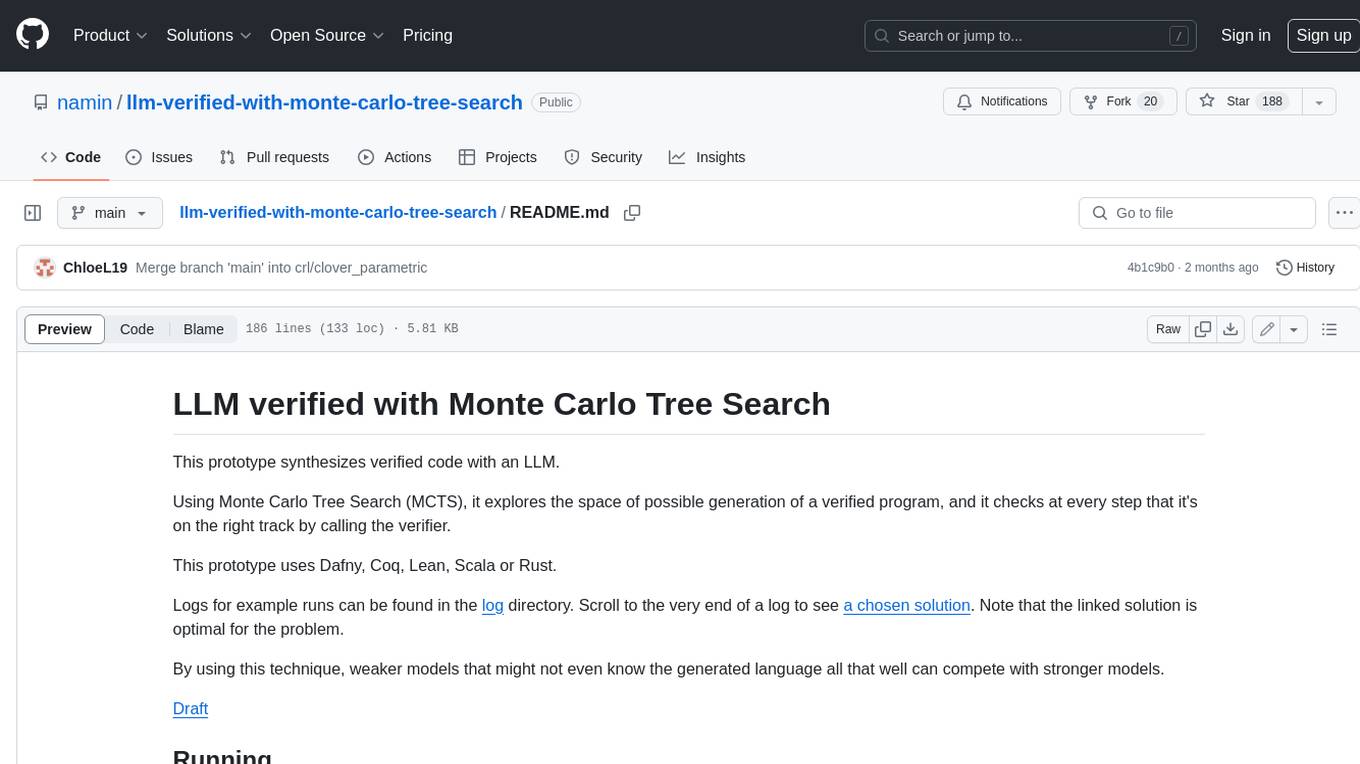
llm-verified-with-monte-carlo-tree-search
This prototype synthesizes verified code with an LLM using Monte Carlo Tree Search (MCTS). It explores the space of possible generation of a verified program and checks at every step that it's on the right track by calling the verifier. This prototype uses Dafny, Coq, Lean, Scala, or Rust. By using this technique, weaker models that might not even know the generated language all that well can compete with stronger models.
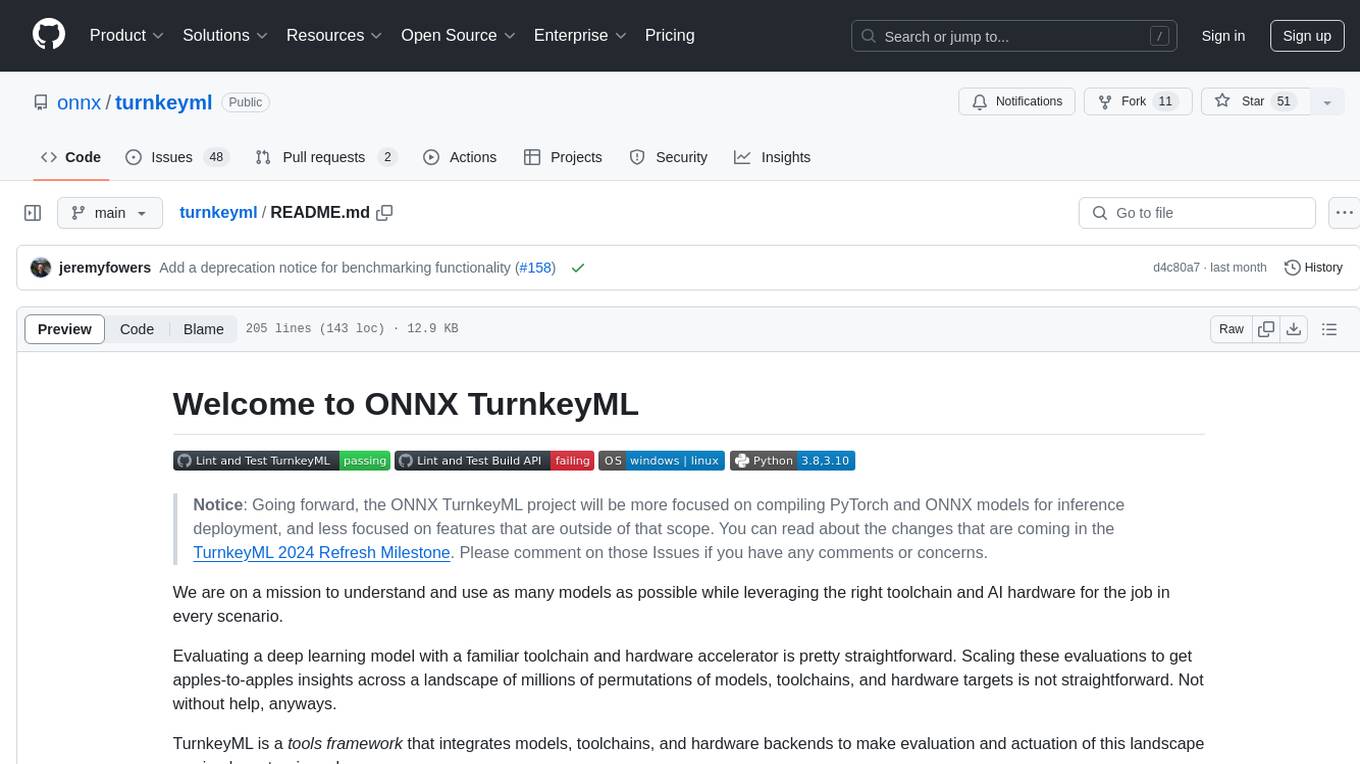
turnkeyml
TurnkeyML is a tools framework that integrates models, toolchains, and hardware backends to simplify the evaluation and actuation of deep learning models. It supports use cases like exporting ONNX files, performance validation, functional coverage measurement, stress testing, and model insights analysis. The framework consists of analysis, build, runtime, reporting tools, and a models corpus, seamlessly integrated to provide comprehensive functionality with simple commands. Extensible through plugins, it offers support for various export and optimization tools and AI runtimes. The project is actively seeking collaborators and is licensed under Apache 2.0.
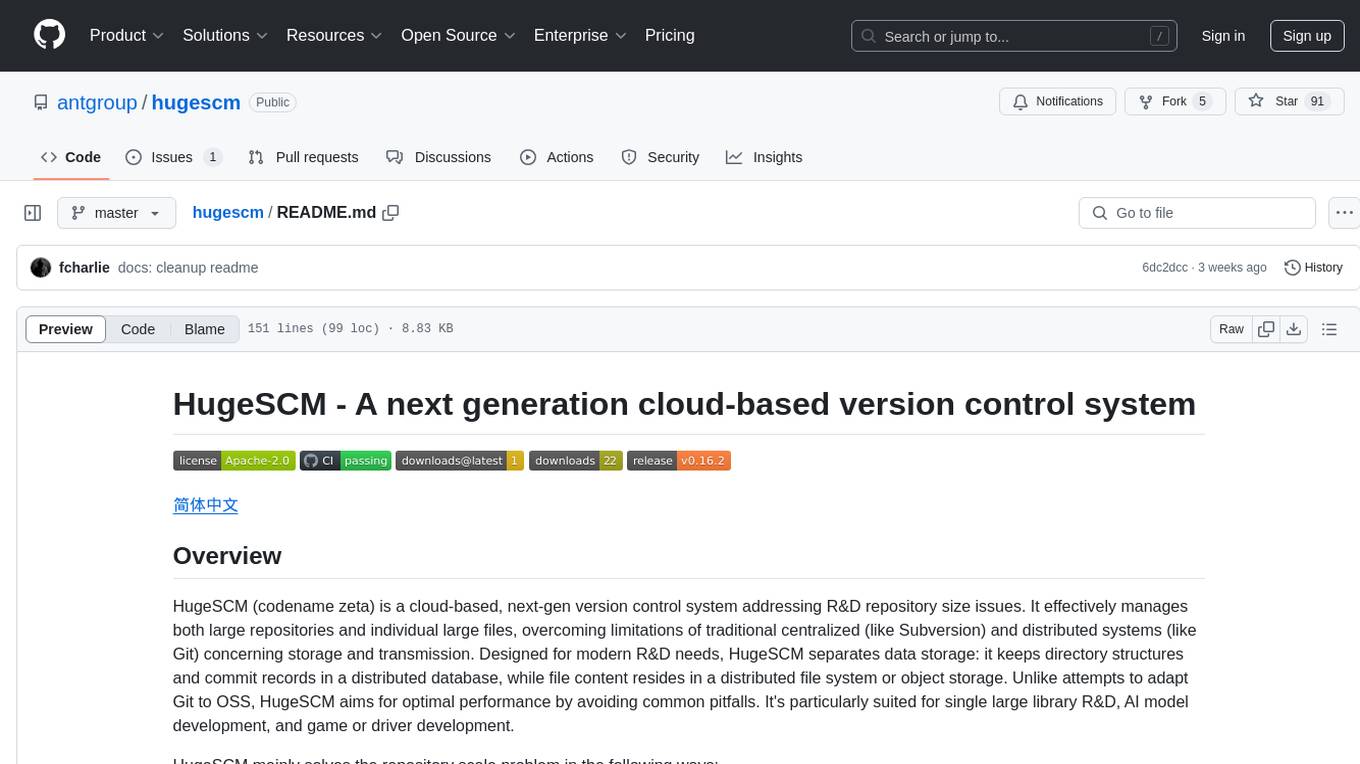
hugescm
HugeSCM is a cloud-based version control system designed to address R&D repository size issues. It effectively manages large repositories and individual large files by separating data storage and utilizing advanced algorithms and data structures. It aims for optimal performance in handling version control operations of large-scale repositories, making it suitable for single large library R&D, AI model development, and game or driver development.
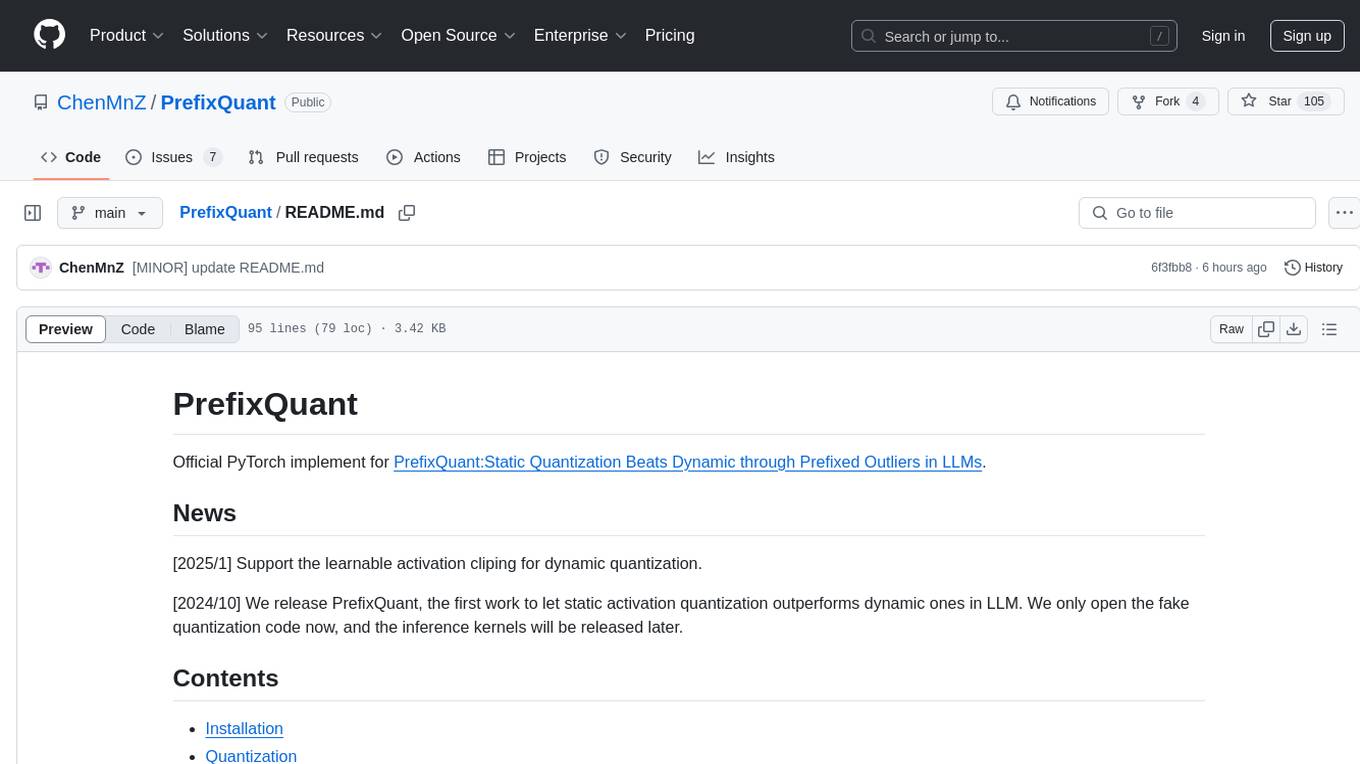
PrefixQuant
PrefixQuant is an official PyTorch implementation for static quantization that outperforms dynamic quantization in Large Language Models (LLMs) by utilizing prefixed outliers. The tool provides functionalities for quantization, inference, and visualization of activation distributions. Users can fine-tune quantization settings and evaluate pre-quantized models for tasks like PIQA, ARC, Hellaswag, and Winogrande. The approach aims to improve performance and efficiency in LLMs through innovative quantization techniques.
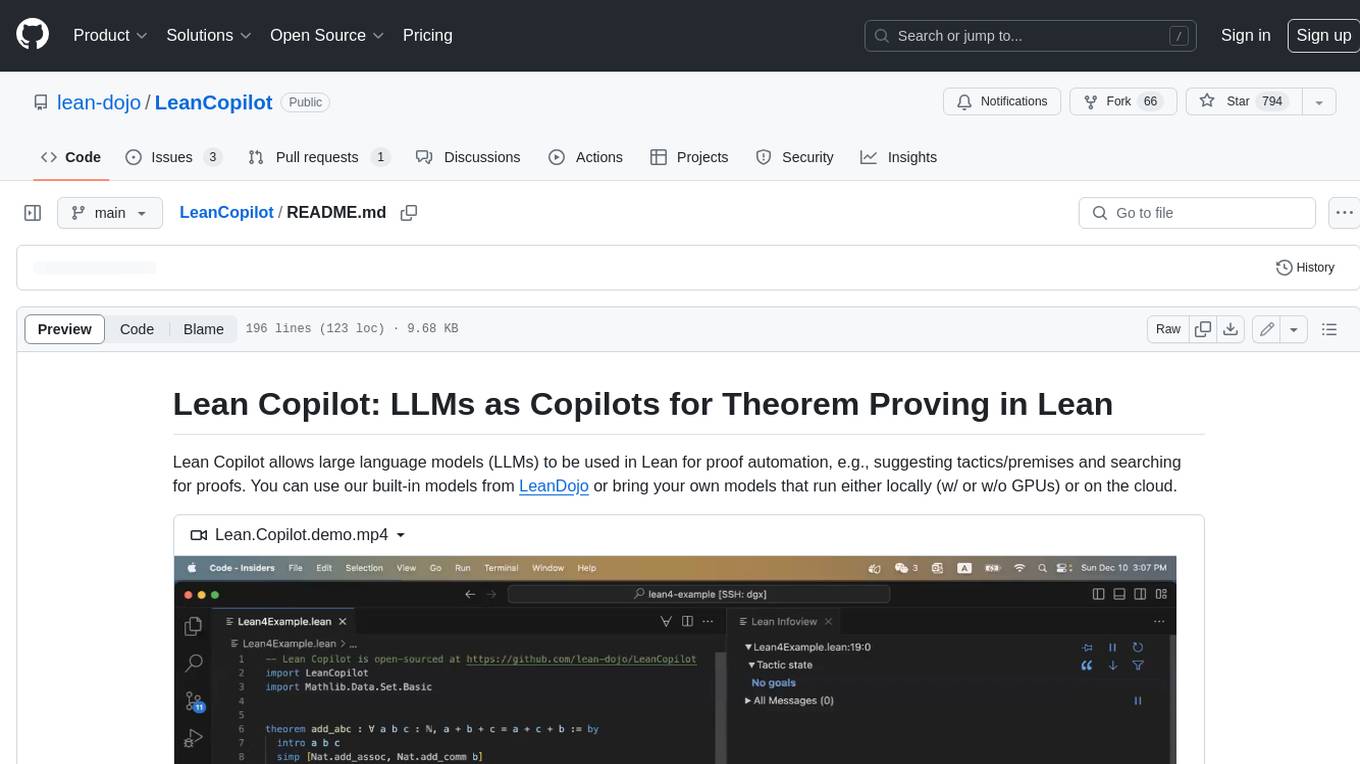
LeanCopilot
Lean Copilot is a tool that enables the use of large language models (LLMs) in Lean for proof automation. It provides features such as suggesting tactics/premises, searching for proofs, and running inference of LLMs. Users can utilize built-in models from LeanDojo or bring their own models to run locally or on the cloud. The tool supports platforms like Linux, macOS, and Windows WSL, with optional CUDA and cuDNN for GPU acceleration. Advanced users can customize behavior using Tactic APIs and Model APIs. Lean Copilot also allows users to bring their own models through ExternalGenerator or ExternalEncoder. The tool comes with caveats such as occasional crashes and issues with premise selection and proof search. Users can get in touch through GitHub Discussions for questions, bug reports, feature requests, and suggestions. The tool is designed to enhance theorem proving in Lean using LLMs.
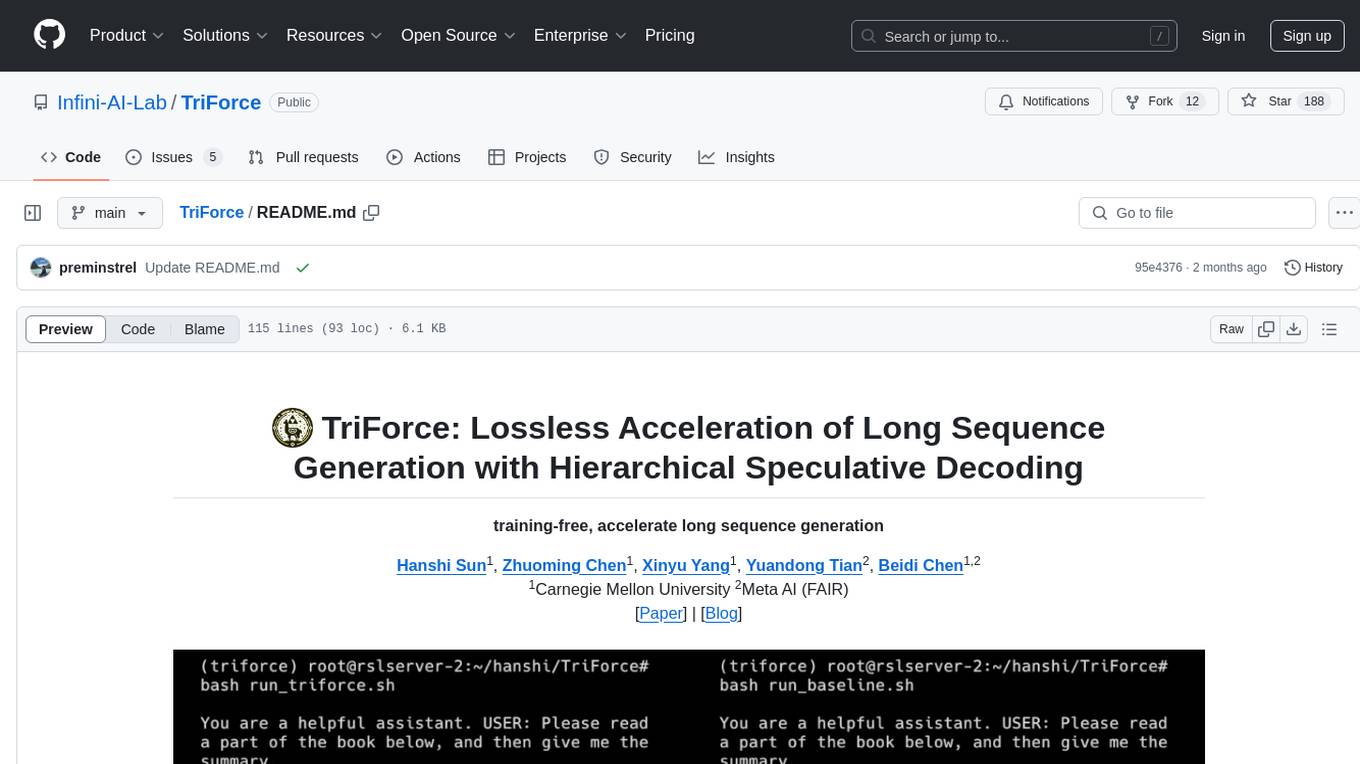
TriForce
TriForce is a training-free tool designed to accelerate long sequence generation. It supports long-context Llama models and offers both on-chip and offloading capabilities. Users can achieve a 2.2x speedup on a single A100 GPU. TriForce also provides options for offloading with tensor parallelism or without it, catering to different hardware configurations. The tool includes a baseline for comparison and is optimized for performance on RTX 4090 GPUs. Users can cite the associated paper if they find TriForce useful for their projects.
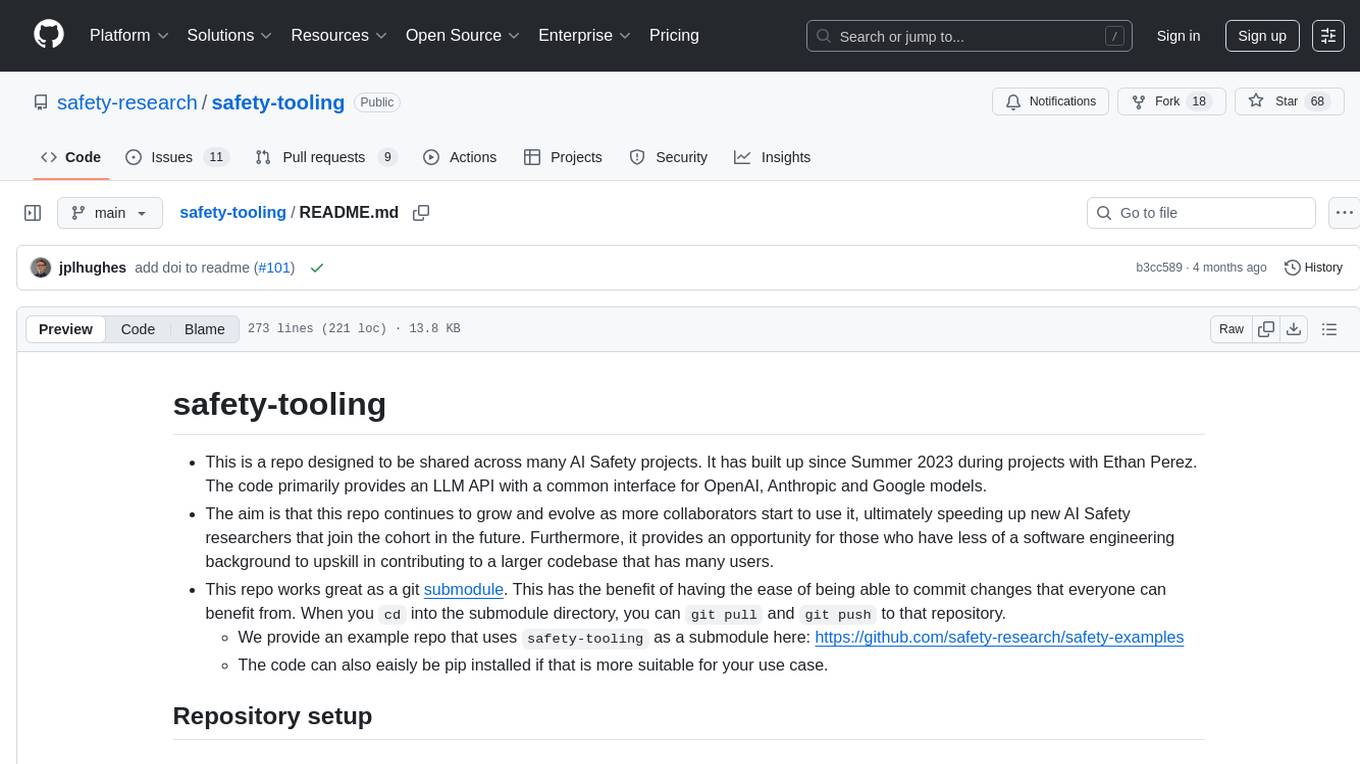
safety-tooling
This repository, safety-tooling, is designed to be shared across various AI Safety projects. It provides an LLM API with a common interface for OpenAI, Anthropic, and Google models. The aim is to facilitate collaboration among AI Safety researchers, especially those with limited software engineering backgrounds, by offering a platform for contributing to a larger codebase. The repo can be used as a git submodule for easy collaboration and updates. It also supports pip installation for convenience. The repository includes features for installation, secrets management, linting, formatting, Redis configuration, testing, dependency management, inference, finetuning, API usage tracking, and various utilities for data processing and experimentation.
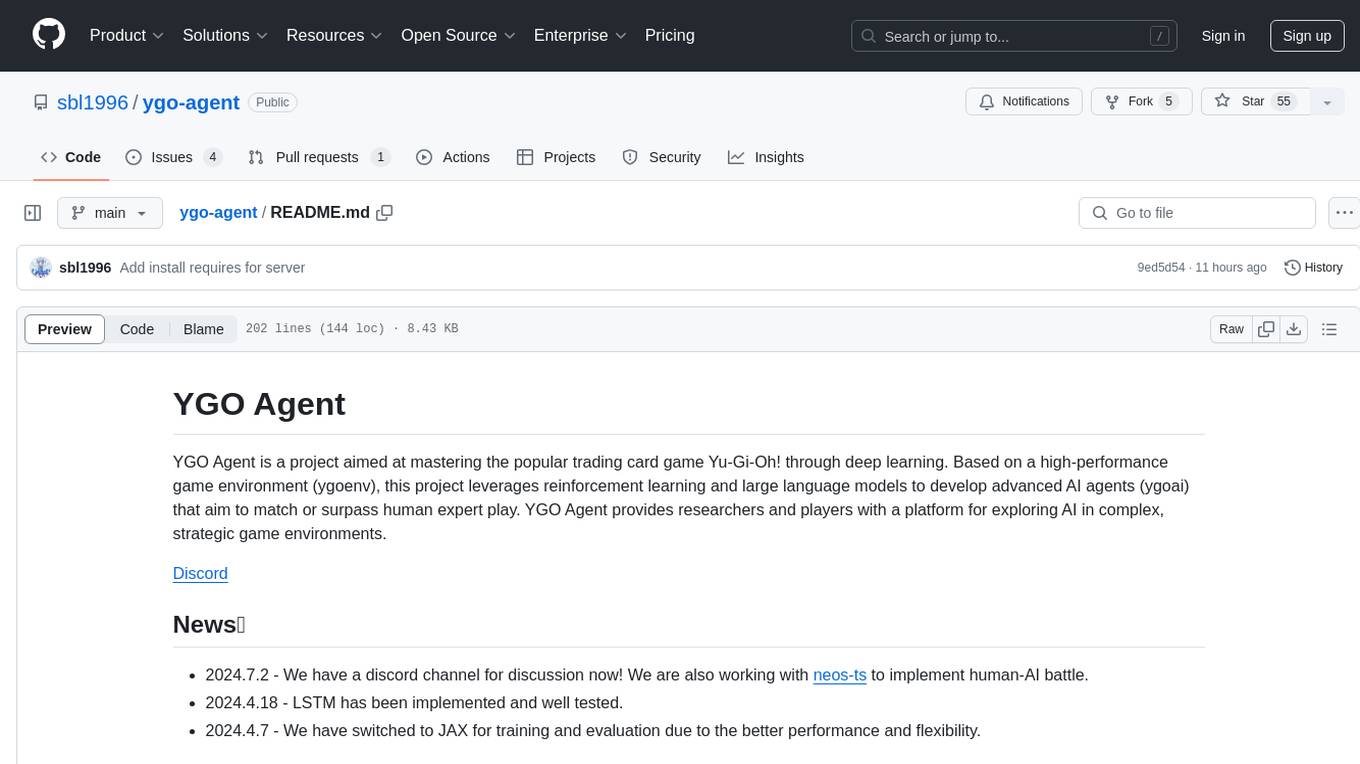
ygo-agent
YGO Agent is a project focused on using deep learning to master the Yu-Gi-Oh! trading card game. It utilizes reinforcement learning and large language models to develop advanced AI agents that aim to surpass human expert play. The project provides a platform for researchers and players to explore AI in complex, strategic game environments.
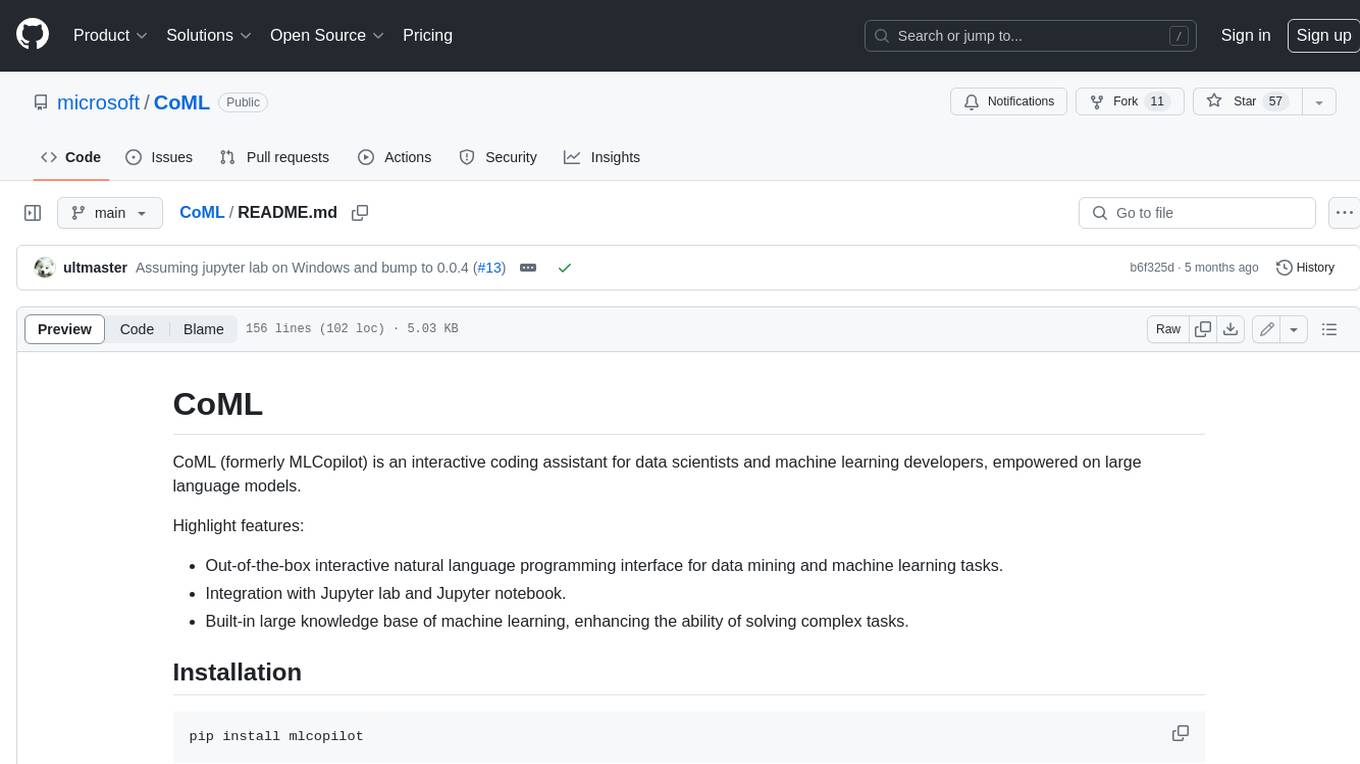
CoML
CoML (formerly MLCopilot) is an interactive coding assistant for data scientists and machine learning developers, empowered on large language models. It offers an out-of-the-box interactive natural language programming interface for data mining and machine learning tasks, integration with Jupyter lab and Jupyter notebook, and a built-in large knowledge base of machine learning to enhance the ability to solve complex tasks. The tool is designed to assist users in coding tasks related to data analysis and machine learning using natural language commands within Jupyter environments.
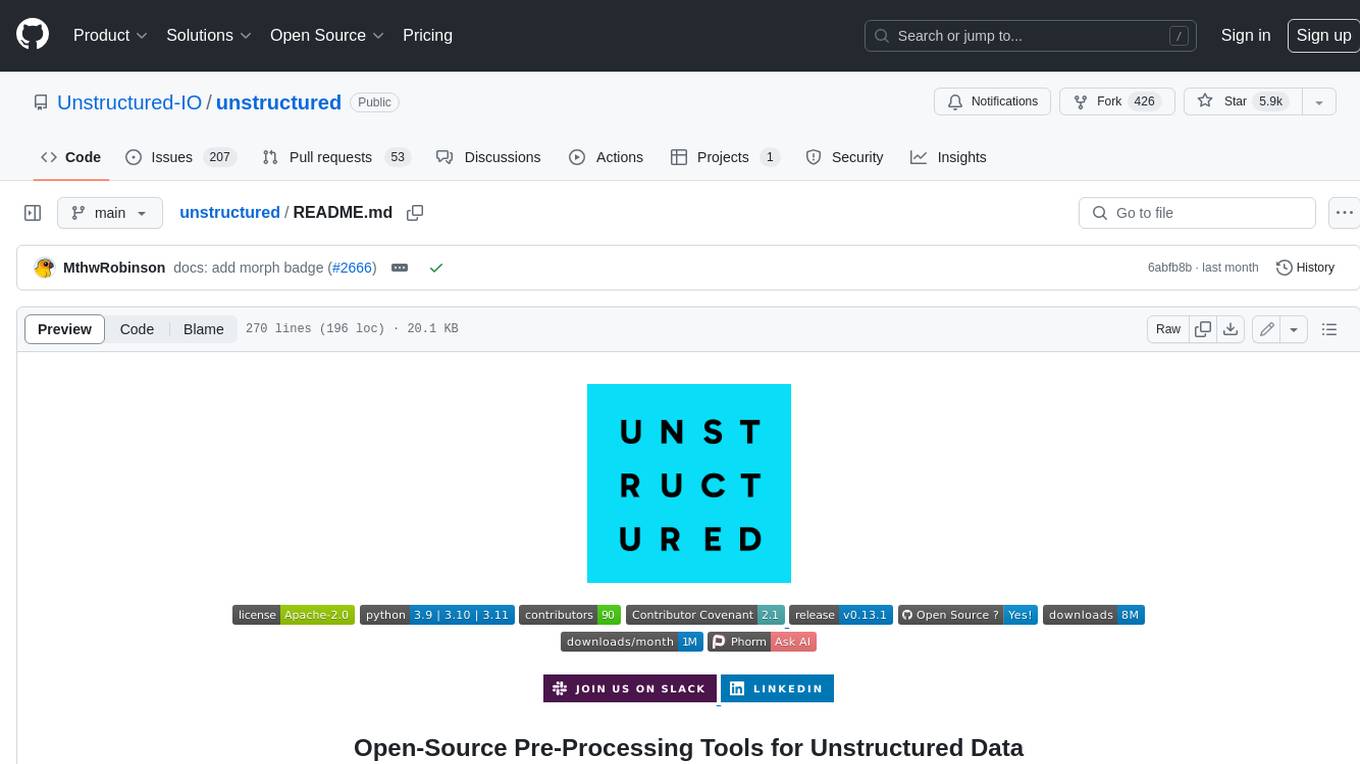
unstructured
The `unstructured` library provides open-source components for ingesting and pre-processing images and text documents, such as PDFs, HTML, Word docs, and many more. The use cases of `unstructured` revolve around streamlining and optimizing the data processing workflow for LLMs. `unstructured` modular functions and connectors form a cohesive system that simplifies data ingestion and pre-processing, making it adaptable to different platforms and efficient in transforming unstructured data into structured outputs.
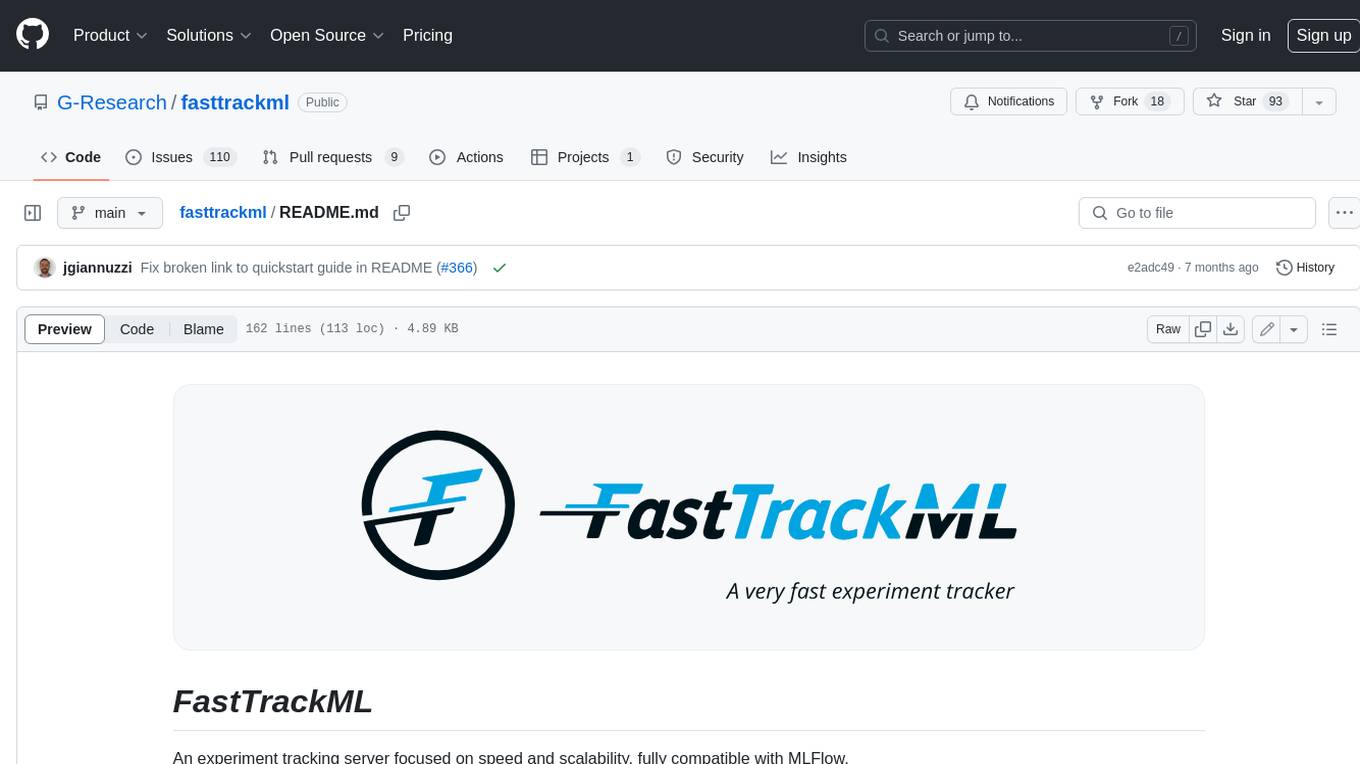
fasttrackml
FastTrackML is an experiment tracking server focused on speed and scalability, fully compatible with MLFlow. It provides a user-friendly interface to track and visualize your machine learning experiments, making it easy to compare different models and identify the best performing ones. FastTrackML is open source and can be easily installed and run with pip or Docker. It is also compatible with the MLFlow Python package, making it easy to integrate with your existing MLFlow workflows.
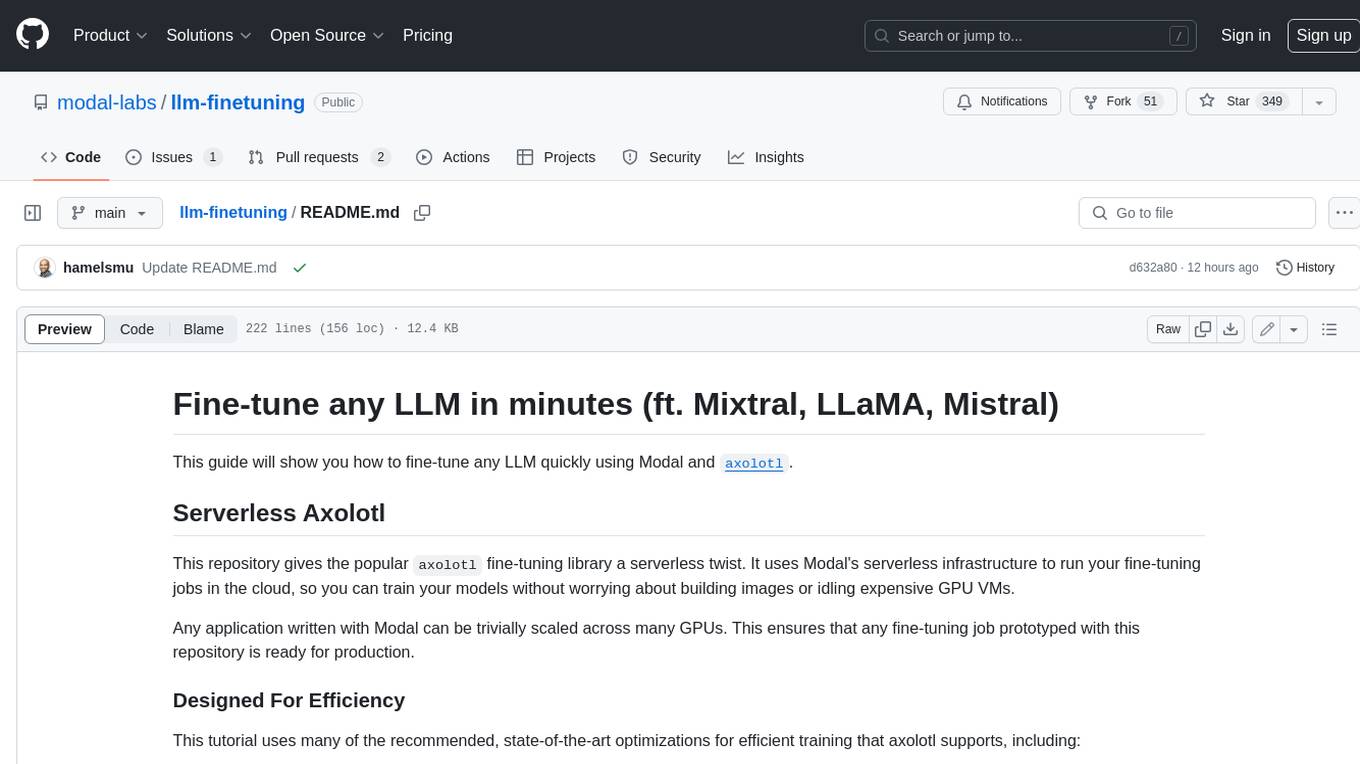
llm-finetuning
llm-finetuning is a repository that provides a serverless twist to the popular axolotl fine-tuning library using Modal's serverless infrastructure. It allows users to quickly fine-tune any LLM model with state-of-the-art optimizations like Deepspeed ZeRO, LoRA adapters, Flash attention, and Gradient checkpointing. The repository simplifies the fine-tuning process by not exposing all CLI arguments, instead allowing users to specify options in a config file. It supports efficient training and scaling across multiple GPUs, making it suitable for production-ready fine-tuning jobs.
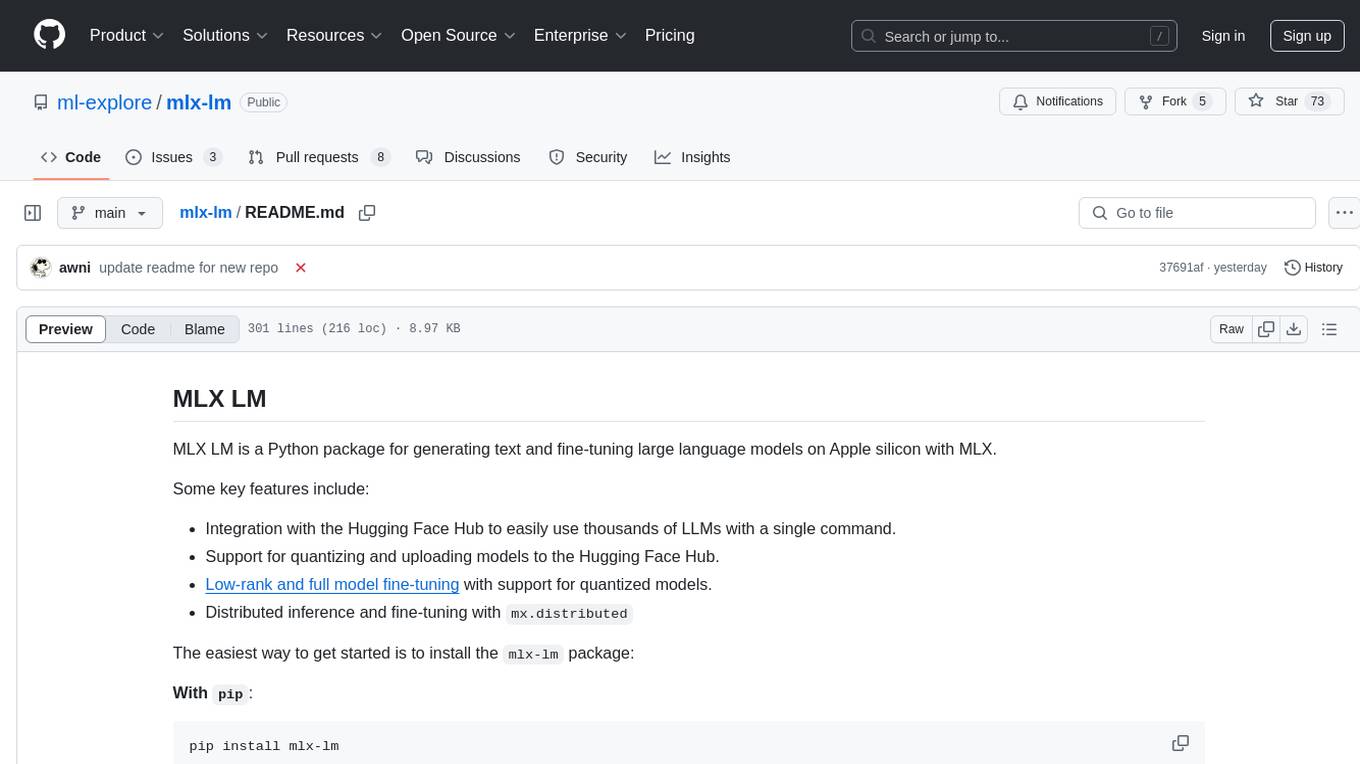
mlx-lm
MLX LM is a Python package designed for generating text and fine-tuning large language models on Apple silicon using MLX. It offers integration with the Hugging Face Hub for easy access to thousands of LLMs, support for quantizing and uploading models to the Hub, low-rank and full model fine-tuning capabilities, and distributed inference and fine-tuning with `mx.distributed`. Users can interact with the package through command line options or the Python API, enabling tasks such as text generation, chatting with language models, model conversion, streaming generation, and sampling. MLX LM supports various Hugging Face models and provides tools for efficient scaling to long prompts and generations, including a rotating key-value cache and prompt caching. It requires macOS 15.0 or higher for optimal performance.
For similar tasks

fsdp_qlora
The fsdp_qlora repository provides a script for training Large Language Models (LLMs) with Quantized LoRA and Fully Sharded Data Parallelism (FSDP). It integrates FSDP+QLoRA into the Axolotl platform and offers installation instructions for dependencies like llama-recipes, fastcore, and PyTorch. Users can finetune Llama-2 70B on Dual 24GB GPUs using the provided command. The script supports various training options including full params fine-tuning, LoRA fine-tuning, custom LoRA fine-tuning, quantized LoRA fine-tuning, and more. It also discusses low memory loading, mixed precision training, and comparisons to existing trainers. The repository addresses limitations and provides examples for training with different configurations, including BnB QLoRA and HQQ QLoRA. Additionally, it offers SLURM training support and instructions for adding support for a new model.
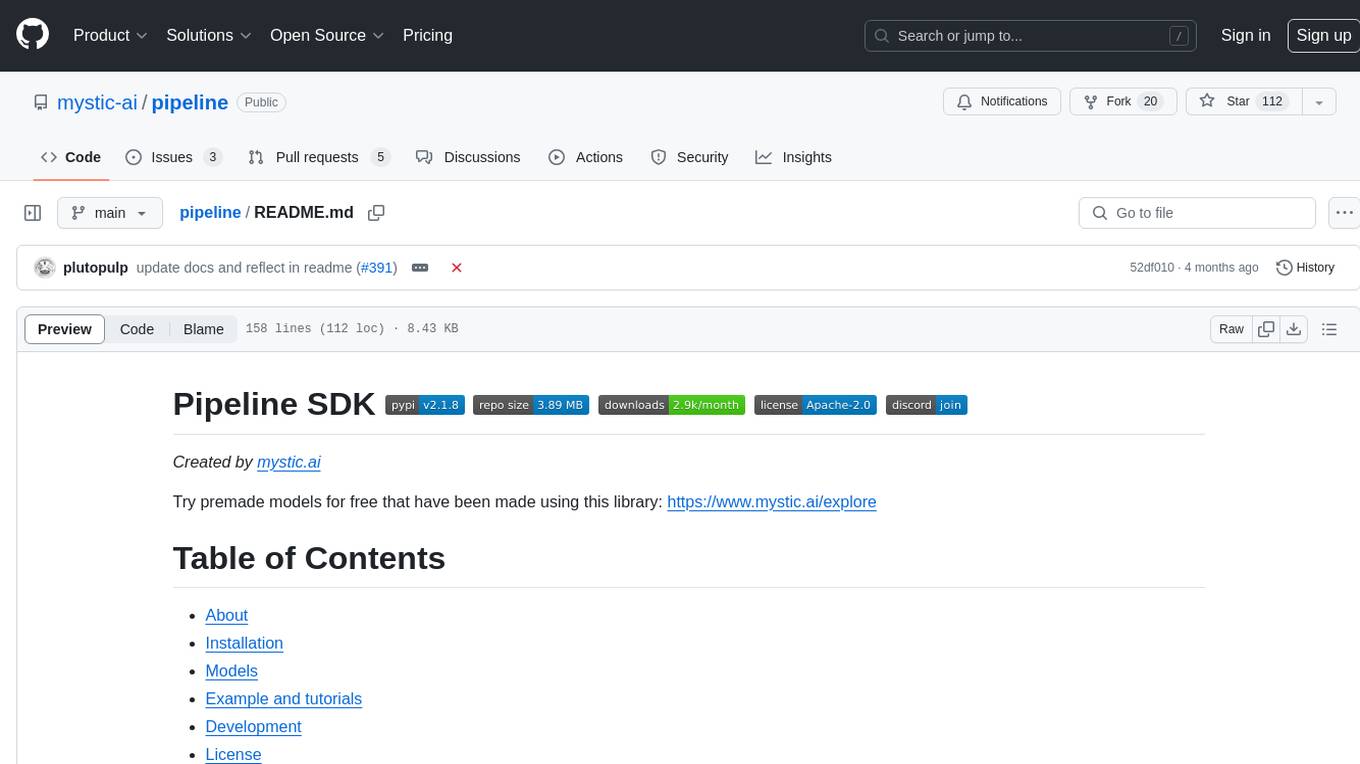
pipeline
Pipeline is a Python library designed for constructing computational flows for AI/ML models. It supports both development and production environments, offering capabilities for inference, training, and finetuning. The library serves as an interface to Mystic, enabling the execution of pipelines at scale and on enterprise GPUs. Users can also utilize this SDK with Pipeline Core on a private hosted cluster. The syntax for defining AI/ML pipelines is reminiscent of sessions in Tensorflow v1 and Flows in Prefect.
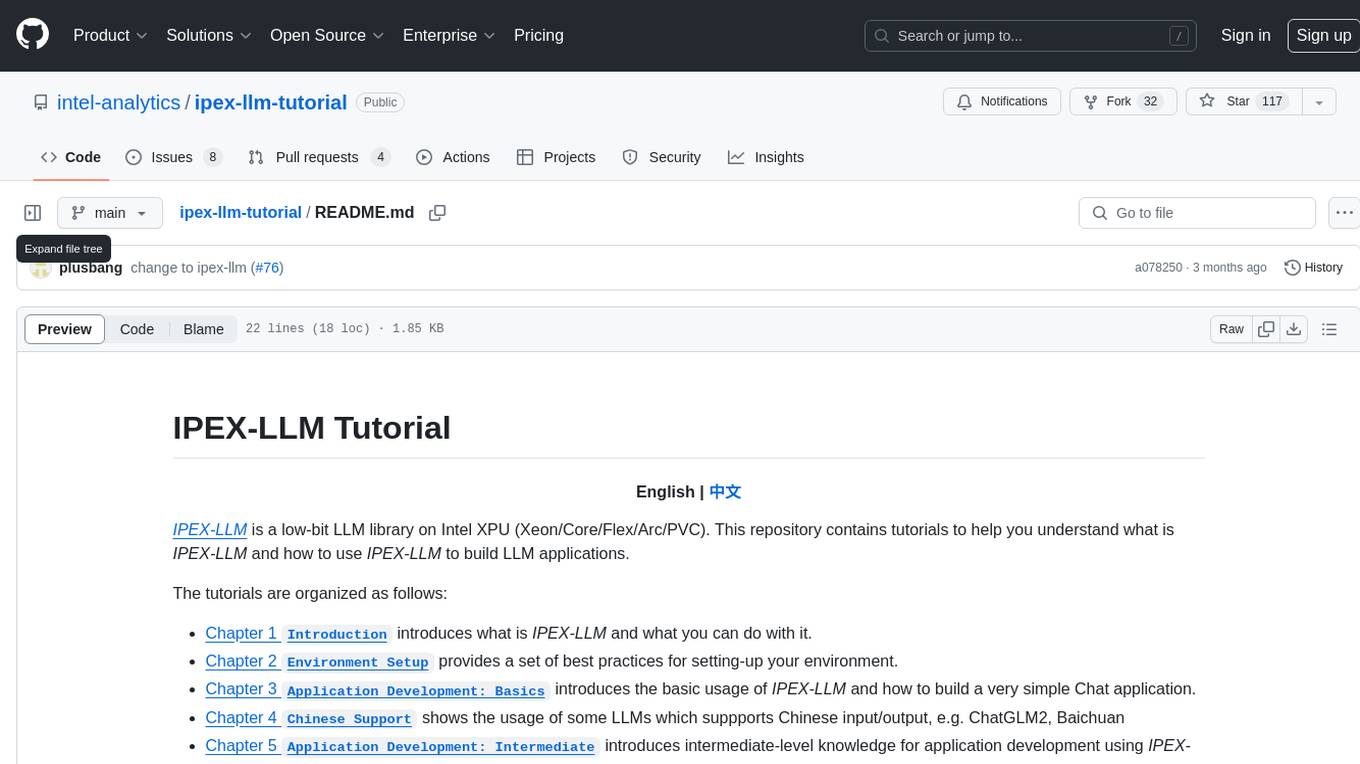
ipex-llm-tutorial
IPEX-LLM is a low-bit LLM library on Intel XPU (Xeon/Core/Flex/Arc/PVC) that provides tutorials to help users understand and use the library to build LLM applications. The tutorials cover topics such as introduction to IPEX-LLM, environment setup, basic application development, Chinese language support, intermediate and advanced application development, GPU acceleration, and finetuning. Users can learn how to build chat applications, chatbots, speech recognition, and more using IPEX-LLM.
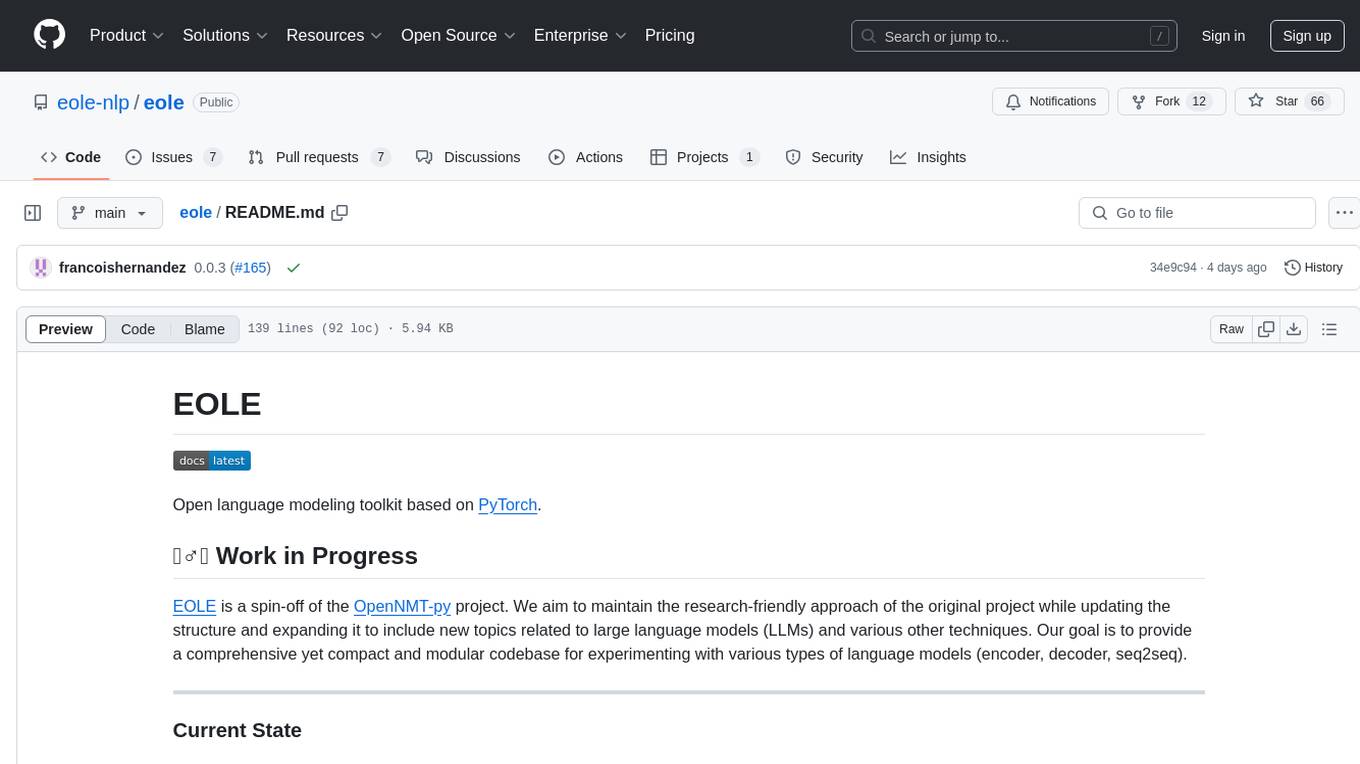
eole
EOLE is an open language modeling toolkit based on PyTorch. It aims to provide a research-friendly approach with a comprehensive yet compact and modular codebase for experimenting with various types of language models. The toolkit includes features such as versatile training and inference, dynamic data transforms, comprehensive large language model support, advanced quantization, efficient finetuning, flexible inference, and tensor parallelism. EOLE is a work in progress with ongoing enhancements in configuration management, command line entry points, reproducible recipes, core API simplification, and plans for further simplification, refactoring, inference server development, additional recipes, documentation enhancement, test coverage improvement, logging enhancements, and broader model support.

LLaSA_training
LLaSA_training is a repository focused on training models for speech synthesis using a large amount of open-source speech data. The repository provides instructions for finetuning models and offers pre-trained models for multilingual speech synthesis. It includes tools for training, data downloading, and data processing using specialized tokenizers for text and speech sequences. The repository also supports direct usage on Hugging Face platform with specific codecs and collections.
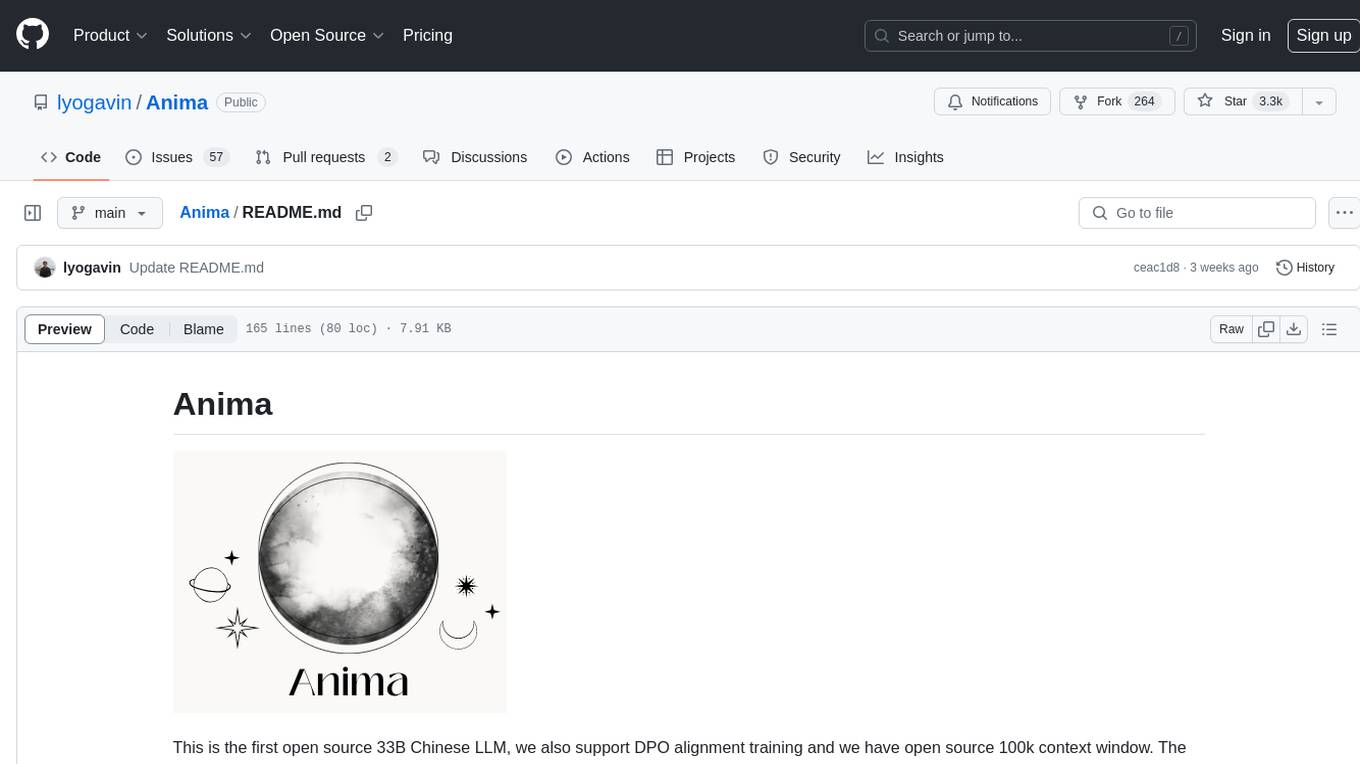
Anima
Anima is the first open-source 33B Chinese large language model based on QLoRA, supporting DPO alignment training and open-sourcing a 100k context window model. The latest update includes AirLLM, a library that enables inference of 70B LLM from a single GPU with just 4GB memory. The tool optimizes memory usage for inference, allowing large language models to run on a single 4GB GPU without the need for quantization or other compression techniques. Anima aims to democratize AI by making advanced models accessible to everyone and contributing to the historical process of AI democratization.
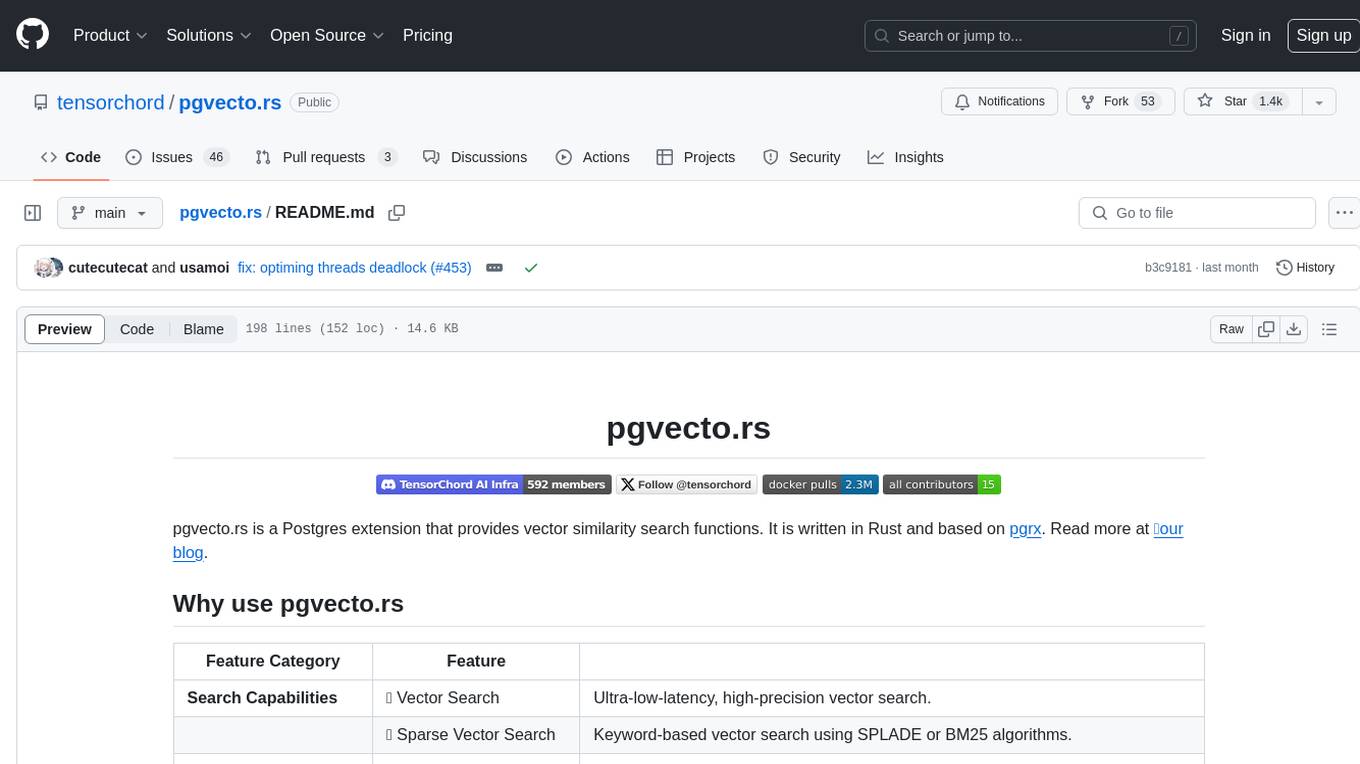
pgvecto.rs
pgvecto.rs is a Postgres extension written in Rust that provides vector similarity search functions. It offers ultra-low-latency, high-precision vector search capabilities, including sparse vector search and full-text search. With complete SQL support, async indexing, and easy data management, it simplifies data handling. The extension supports various data types like FP16/INT8, binary vectors, and Matryoshka embeddings. It ensures system performance with production-ready features, high availability, and resource efficiency. Security and permissions are managed through easy access control. The tool allows users to create tables with vector columns, insert vector data, and calculate distances between vectors using different operators. It also supports half-precision floating-point numbers for better performance and memory usage optimization.
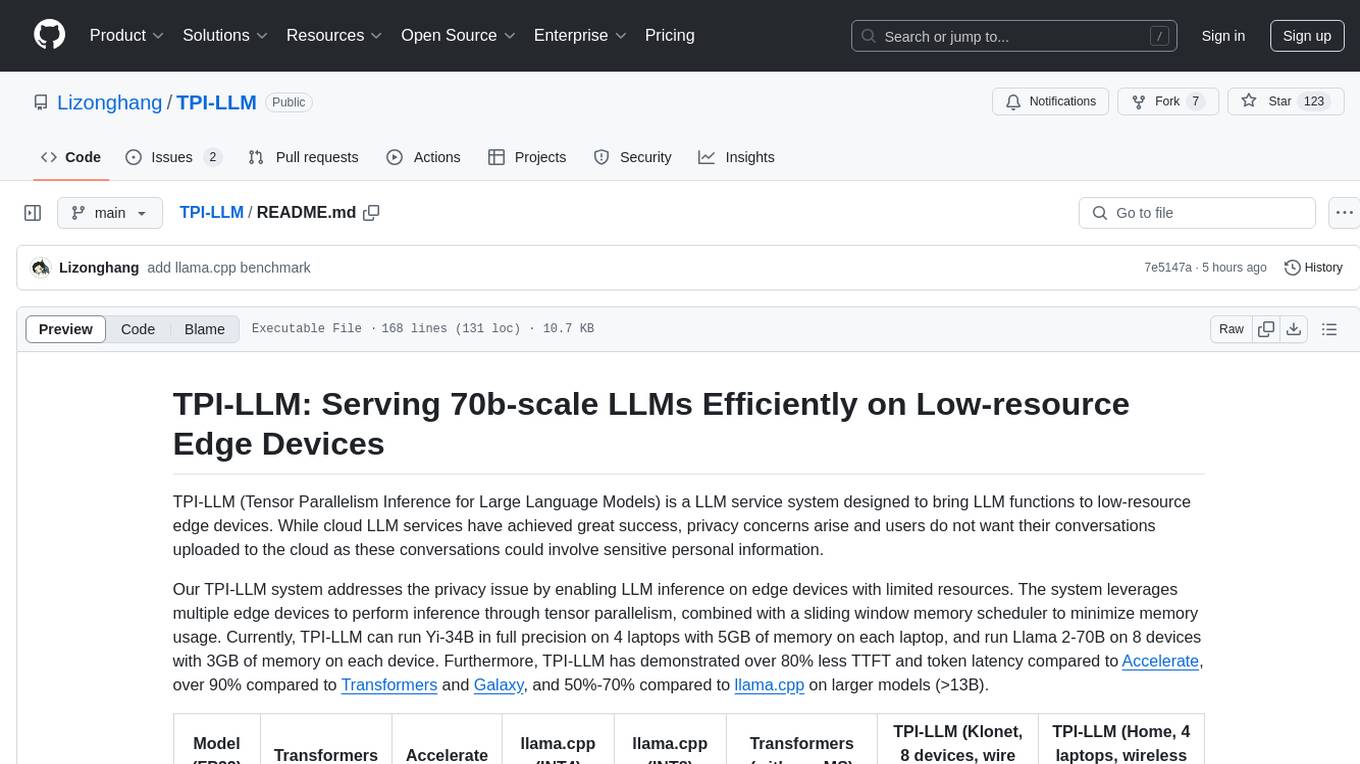
TPI-LLM
TPI-LLM (Tensor Parallelism Inference for Large Language Models) is a system designed to bring LLM functions to low-resource edge devices, addressing privacy concerns by enabling LLM inference on edge devices with limited resources. It leverages multiple edge devices for inference through tensor parallelism and a sliding window memory scheduler to minimize memory usage. TPI-LLM demonstrates significant improvements in TTFT and token latency compared to other models, and plans to support infinitely large models with low token latency in the future.
For similar jobs

sweep
Sweep is an AI junior developer that turns bugs and feature requests into code changes. It automatically handles developer experience improvements like adding type hints and improving test coverage.

teams-ai
The Teams AI Library is a software development kit (SDK) that helps developers create bots that can interact with Teams and Microsoft 365 applications. It is built on top of the Bot Framework SDK and simplifies the process of developing bots that interact with Teams' artificial intelligence capabilities. The SDK is available for JavaScript/TypeScript, .NET, and Python.

ai-guide
This guide is dedicated to Large Language Models (LLMs) that you can run on your home computer. It assumes your PC is a lower-end, non-gaming setup.

classifai
Supercharge WordPress Content Workflows and Engagement with Artificial Intelligence. Tap into leading cloud-based services like OpenAI, Microsoft Azure AI, Google Gemini and IBM Watson to augment your WordPress-powered websites. Publish content faster while improving SEO performance and increasing audience engagement. ClassifAI integrates Artificial Intelligence and Machine Learning technologies to lighten your workload and eliminate tedious tasks, giving you more time to create original content that matters.

chatbot-ui
Chatbot UI is an open-source AI chat app that allows users to create and deploy their own AI chatbots. It is easy to use and can be customized to fit any need. Chatbot UI is perfect for businesses, developers, and anyone who wants to create a chatbot.

BricksLLM
BricksLLM is a cloud native AI gateway written in Go. Currently, it provides native support for OpenAI, Anthropic, Azure OpenAI and vLLM. BricksLLM aims to provide enterprise level infrastructure that can power any LLM production use cases. Here are some use cases for BricksLLM: * Set LLM usage limits for users on different pricing tiers * Track LLM usage on a per user and per organization basis * Block or redact requests containing PIIs * Improve LLM reliability with failovers, retries and caching * Distribute API keys with rate limits and cost limits for internal development/production use cases * Distribute API keys with rate limits and cost limits for students

uAgents
uAgents is a Python library developed by Fetch.ai that allows for the creation of autonomous AI agents. These agents can perform various tasks on a schedule or take action on various events. uAgents are easy to create and manage, and they are connected to a fast-growing network of other uAgents. They are also secure, with cryptographically secured messages and wallets.

griptape
Griptape is a modular Python framework for building AI-powered applications that securely connect to your enterprise data and APIs. It offers developers the ability to maintain control and flexibility at every step. Griptape's core components include Structures (Agents, Pipelines, and Workflows), Tasks, Tools, Memory (Conversation Memory, Task Memory, and Meta Memory), Drivers (Prompt and Embedding Drivers, Vector Store Drivers, Image Generation Drivers, Image Query Drivers, SQL Drivers, Web Scraper Drivers, and Conversation Memory Drivers), Engines (Query Engines, Extraction Engines, Summary Engines, Image Generation Engines, and Image Query Engines), and additional components (Rulesets, Loaders, Artifacts, Chunkers, and Tokenizers). Griptape enables developers to create AI-powered applications with ease and efficiency.